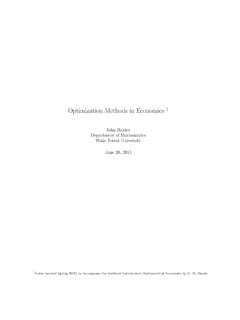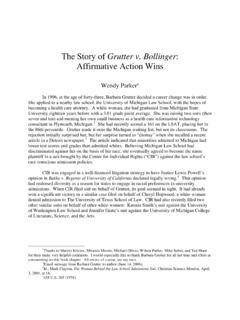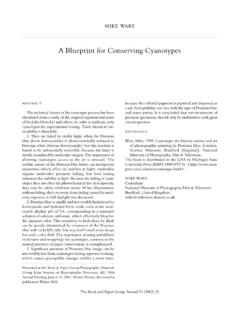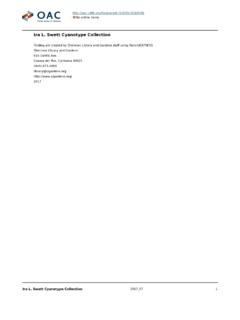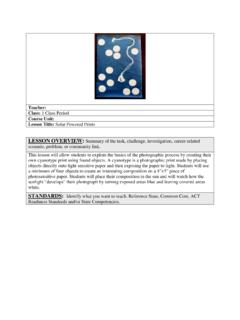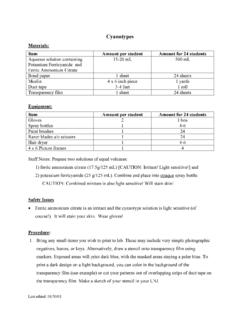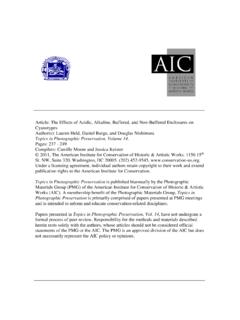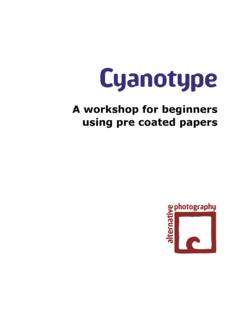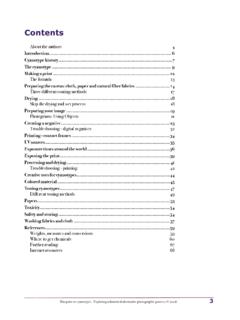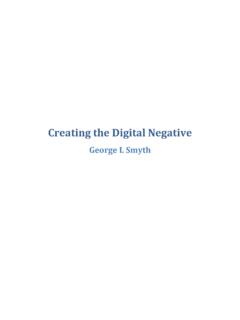Transcription of Blueprint Photography by the Cyanotype Process
1 JCE Classroom Activity: #19 The Cyanotype photographic Process was first developed by Sir John Herschel in the 1840s. Commer-cial Cyanotype paper was available in the 1870s and began to be used by architects for copying drawings(blueprints). Cyanotype printing became popular among amateur photographers toward the end of the19th century because of its simplicity and low cost. However, the bright blue color of the prints preventedits adoption by most serious high energy of ultraviolet (UV) radiation catalyzes many chemical reactions. These include undesirable chemicalreactions in biological organisms, such as DNA mutations.
2 We are protected from the sun s UV rays by the ozone layerin the upper atmosphere, although some UV rays manage to penetrate this protective layer. Exposure of the cyanotypepaper you can make in lab to UV radiation causes reduction of ferric (Fe3+) ions to ferrous (Fe2+) ions. A blue image isproduced as the ferrous ions react with ferricyanide ions to form insoluble iron(III) hexacyanoferrate(II) or Prussian This You will need: sensitizer solution, fine-bristle paintbrush or sponge brush, artist s watercolor or bristol paper, hairdrier, items to photograph , piece of cardboard, piece of cloth, piece of plate glass with sanded or duct-taped edges or aclear acetate sheet and paper clips, 3% hydrogen peroxide solution (optional), and direct sunlight (UV light source).
3 Note: The sensitizer and paper should be kept away from direct sunlight coming through the windows and fluores-cent lights should be turned off. Subdued light coming through the windows and incandescent lights are Your instructor will provide the sensitizer solution that contains equal amounts of ammonium ferric citrate solutionand potassium ferricyanide Use a brush to apply sensitizer solution to one side of a piece of artist s paper. Apply the solution evenly, with brushstrokes in the horizontal direction. Then, without applying more solution, brush in the vertical direction and finallyagain in the horizontal direction.
4 Do not allow excess solution to remain on the Dry the paper thoroughly with a hair drier. Wet sensitizer will stain negatives and other materials. Place the driedpaper on a piece of cardboard to hold it Choose an item you wish to print and place it on the dry, sensitized paper. Things to try: black-and-white negatives(glossy side up), designs drawn with a black felt-tip pen on a clear acetate sheet, paper cutouts, leaves from trees orother plants, a piece of lace, or any flat opaque object with interesting Cover the paper and object with a piece of plate glass with sanded or duct-taped edges to hold the assembly flatwhen it is exposed to sunlight.
5 If plate glass is not available, paper-clip an acetate sheet to the Cyanotype paper. Be surethe clips do not block your image. Cover this assembly with a piece of cloth to carry it into direct Place the paper on a stable surface such as a table or the ground. Remove the cloth cover to expose the sensitizedpaper to direct sunlight. What happens? The length of time needed to see a change will depend on your location, thetime of year, the time of day, and cloud density. (For example, the exposure time can be 5 minutes on a sunny summerday, but 20 minutes on a sunny winter day.)
6 __7. When the exposed paper is dark, cover it again with the cloth. Take it inside, remove the cover and object, and washthe paper in a sink under cool running water for 10 minutes. Allow the paper to dry. What color is the paper whereUV rays were blocked?__8. You can darken the image by immersing the washed paper in 3% hydrogen peroxide for 10 seconds and then rinsingwith Most photographic work involving light-sensitive film or paper must be done in a dark room. Why can papersensitized to make cyanotypes be handled in a lighted room?__2. The ozone layer in the upper atmosphere protects us from most, but not all, UV radiation.
7 Why is UV light harmfulto living organisms, but visible and infrared light are not?Information from the World Wide Web1. Cyanotypes by Mike Ware. The New Cyanotype Process . UV Primer (click on UV Primer ). SideBlueprint Photography by the CyanotypeProcessby Glen D. Lawrence and Stuart Fishelson, Long Island University, Brooklyn, NY 11201 This Activity Sheet may be reproduced for use in the subscriber s Journal of Chemical Education Vol. 76 No. 9 September 1999
